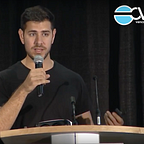Pacific North-West Tour: Complete
Well done Seattle & Vancouver.
Your cities have it together in terms of your virtual reality communities. After a four-day tour of the beautiful northern cities, I am left with a feeling that neither has much to envy from Silicon Valley, where VR is (arguably) being born and pioneered.
I left San Francisco this past Wednesday evening to make my way up to Seattle to host a meeting at Tim Reha’s CNDY Factory — an in-progress revival and transformation of a historic hard-candy factory into a mixed-reality studio, accelerator and community space. Sounds hipster but trust me it isn’t. It’s all blood, sweat and tears, manufactured under the steady guise of Tim.
A whole 24 hours later, I made my way up to Vancouver for the sold-out Consumer VR conference (CVR), where I was invited to speak about emotions and behaviour in VR.
Here’s a quick recap of the fun and business
First Stop: Tim Reha’s CNDY Factory
Here, Tim held the inaugural Lunch2Learn VR series. I was graciously invited to go to Seattle to kick-off the event and talk about Retinad’s Analytics Platform. The sold-out event yielded a healthy mixture of the city’s tech, design and business communities.
The meetup was perhaps the most familial I’ve been to and being present for 80-degree weather, Tim spontaneously decided to host everyone on the up-stairs-garden portion of his space. We had great conversation about the difficulties in developing in VR and the particularities of VR UI/UX. Speaking of Retinad’s gaze-heatmaps, I noted that the tool was currently being used by studios in Hollywood to help them drive better design decisions by showing them what was working and (more importantly) what wasn’t. The audience
I definitely appreciated how engaged everyone was. Each person there had an interesting piece of information or insight to contribute. After our discussion we headed down to the studio-portion of the space where I walked everyone through analytics in VR.
Throughout my presentation I made the following arguments:
- VR content, as is, is not very compelling. That’s because nobody is truly using a data-driven approach to understanding design in VR.
- We need a new grammar for VR. The medium is new and required a lot of thought-leaders to pioneer experiments to see what works and what doesn’t. Stanford’s d.School did a great job.
- Once the above happens, more headsets will be sold because content will finally become compelling enough for the average consumer to spend more than 25 minutes inside a headset.
Second stop: Beautiful British-Columbia
After that wonderful afternoon, it was time to start packing my bags and making my way to Vancouver for the first-ever Consumer VR conference and expo.
The purpose of the trip was to meet the VR community, which I heard was one of the best in the world, and spread the VR-analytics gospel. My second objective was to demonstrate how emotion and behavior in VR can be quantified using nothing more than the headset. This speech related to the R&D portion of Retinad and I must thank my colleagues Charles Etienne and Pierre Cliche helping me nail the science-heavy portions of the talk. (Merci!)
But something unexpected and magical happened. The event, which had a capacity of 2500 people, sold out and it seemed like nearly every single person showed up. This was the most packed VR event I’ve ever seen — even outdoing VRLA and Jon’s SVVR in terms of the amount of people. Kudos to Archiact, the Vancouver-based game and VR studio for having thrown an exceptional event. It was one of the most well-oiled conferences I’ve ever attended. The amount of thought and detail that went into the event is obvious. Kudos on making one hell of a statement Robyn Gummer and the rest of the Archiact team.
Above you see yours truly deep in the middle of the presentation on ‘Emotion and Behaviour in VR;. Standing before a full-house of about 250 people, I spoke about:
- How emotion works in VR and how what happens in VR translates to learned behaviour in the real world
- Studies conducted by Stanford professor Jeremy Bailensen which demonstrated the impact of VR on the human condition.
- Internal studies conducted by our neuroscientists and R&D team led by Charles Etienne, demonstrating how we’re capturing behavioural data with just a headset
That’s a wrap for me. I leave the PNW thoroughly impressed and excited about what the companies up north will manage to accomplish in the coming months and years. Im calling it: a unicorn VR company will be born in either Seattle or Vancouver.
My name is Alexander Haque and I’m the proud Director of Developer Relations at retinadVR. We’re developing the analytics platform for virtual reality that will help track, measure and understand how users are engaging within VR experiences. I’d invite you to chat with me via alex@retinadvr.com or simply by going to retinad.io to learn more
